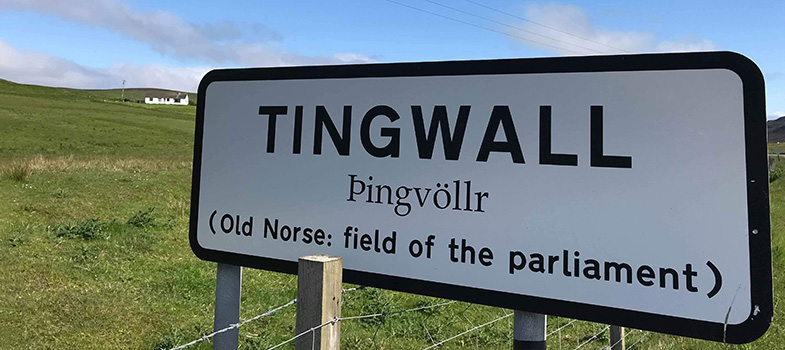3.3 Scottish curricula: language and literature
University literature curricula in Scotland had been, until relatively recently, almost completely devoid of Scots language.
It was as late as 1971 before the University of Glasgow established the first ever chair in Scottish Literature, and from this point onwards interest in Scottish writing has grown, with all of the leading Scottish universities now delivering courses in Scottish Literature in one form or another.

This movement has taken time to trickle down through teacher-training institutions into classrooms where, finally, and at long last, canonical English literature is beginning to give way to a more inclusive spread of literary texts, and to a representative range of Scottish texts.
Curricular bodies have been decidedly slow and conservative in moving to accept, and eventually to promote, Scottish texts in the classroom. A profession that had itself until recently been educated solely in English literature was also - either through reasons of insecurity or ignorance - reluctant to embrace the teaching and promotion of Scottish literature.
Eventually, however, some restricted (and rather ambiguous) acknowledgement was made of Scots language and Scottish literature within the official guidelines for the Year 5—14 curriculum [Tip: hold Ctrl and click a link to open it in a new tab. (Hide tip)] during the early nineteen nineties. This meant that some promotion of Scottish literature and the ‘dialects’ of Scotland was finally permissible and, to some extent, legitimised in the classroom. Scots language and Scottish literature had gained a small curricular foothold.
The subsequent inclusion of ‘compulsory’ Scottish texts within the ‘Higher Still’ qualifications framework of the late nineties and within the new, contemporary National Qualifications has not been without controversy. Some professionals expressed outrage at being ‘dictated to’ about what they were expected to teach. Others questioned how the term ‘Scottish Text’ could be defined. Some even complained that there was insufficient Scottish writing of the quality required for classroom use.
Nevertheless, we have arrived at a point where all youngsters taking National Five or Higher English in Scottish schools now read and answer on at least one canonical Scottish text, and a new generation of teachers has grown up who have a deeper affinity with and greater empathy for Scottish literature and language. (The sterling efforts of the smaller band of enthusiasts who insisted on teaching Scottish literature, language and history to youngsters during the sixties, seventies and eighties should not, however, be overlooked.)
Most of the specified texts in use today are Scottish texts written in English, so there is a limit to the amount of Scots language that youngsters will encounter through the study of literature. However, Alan Spence’s drama Sailmaker (1988) uses Scots dialogue; the stories of Anne Donovan are written in Glaswegian Scots; Lewis Grassic Gibbon’s Sunset Song utilises a range of Scots vocabulary (within a mostly English narrative); the group of Burns’ poems specified for Higher English are written in rich, braid Scots.
![]()
In which ways do you think the inclusion of Scottish (or Scots) texts might enhance or promote young peoples’ learning in Scottish classrooms?
Depending on the answer you gave for the previous question, what more can you say about novels or poets which were taught at your school and the links they have to promoting a sense of national identity?
By 2009, the new Curriculum for Excellence was establishing itself in Scottish schools. Education Scotland’s ‘Principles and Practice’ document for English and Literacy published in the same year went a little further than the previous 5—14 curriculum had gone in its referencing of Scottish culture, language and literature:
“The languages, dialects and literature of Scotland provide a rich resource for children and young people to learn about Scotland’s culture, identity and language … it is expected that practitioners will build upon the diversity of language represented within the communities of Scotland, valuing the languages which children and young people bring to school.”
It is unfortunate that the writers of this document did not go as far as to identify the ‘languages’ of Scotland as English, Scots and Gaelic, or that specific reference to Scottish language and culture were left out of the governing ‘Experiences and Outcomes’ documents of Curriculum for Excellence. The inclusion of the word ‘dialect’ seems a well-meaning addition, but probably muddies the waters somewhat for teachers. ‘Dialect’ suggests a sub-set of language, and for many people the word carries negative connotations.
If Scots can be considered a ‘language’ with parity to English or Gaelic, it is much more likely to be taken seriously; even to refer to it as ‘language’, if not as ‘a language’, helps to raise the status of Scots. ‘The diversity of languages represented within the communities of Scotland’ is also open to ambiguous interpretation; does this refer to Gaelic and Scots, or to Urdu, Cantonese, Polish, or to all of these languages?
But the overall tone of the paragraph and its references to Scottish culture remain positive, and send the clear signal that it is good for Scottish youngsters to learn about Scottish things.
The increased emphasis placed on Scottish culture in the Curriculum for Excellence has begun to filter through into schools, and by April 2015 schools HMIE inspectors (full title “Her Majesty’s Inspectorate of Education”) were in a position to make the following comments on the place of Scots within the curriculum:
“Across all sectors, staff are increasingly using Scots and Scottish texts to develop children’s and young people’s literacy skills. The next step for many schools is to plan opportunities for children and young people to use Scots language, and Scots and Scottish texts, beyond one-off events such as for St Andrew’s Day or Burns celebrations.
A knowledge and understanding of Scots language and Scottish texts allows children and young people to explore and appreciate Scottish culture. Learning Scots can often improve learners’ engagement in learning and their development of wider literacy skills. Through Scots, learners can explore language in more depth, making connections and comparisons with the linguistic structures and vocabularies of other languages.
Scots as a context for learning can also provide an engaging platform for children and young people to explore language, register and audience. It can encourage reluctant readers and writers to become involved as texts in Scots can capture the imagination and speak to them in a familiar voice.”
So, far from being considered an ‘impediment’, as John G. Shearer put it some sixty years earlier, the idea of having access to different languages or linguistic forms is now being recognised as a strength and an advantage.
A central tenet of the Curriculum for Excellence is that learning should be relevant and personalised; it seems clear that part of the process of ‘personalising’ learning includes learning about Scotland, its languages and its culture.
Activity 6
Compare the above communication from Scottish education inspectors to the quote from John G. Shearer (1952) you read in section 3.2 and is repeated below. Write a few sentences describing the shift in attitudes to Scots between 1952 and 2015, based on your reading of the two extracts.
“The schools have been urging the use of formal English for many years, but it is doubtful whether there has been any improvement during the twentieth century. It is equally likely that the language has become debased in that time. Most people dislike interference with their accustomed manner of speaking, and though they learn to speak Standard English in school, they revert to their accustomed idiom outside. No part of our work suffers more from the opposition of outside interests than this.
The use of dialect along with Standard English imposes on our young people the handicap of bilingualism that they habitually use two languages. This is a real impediment to progress. Further, the dialects are not pretty and their literature is small.
Therefore, as we now have the assistance of the radio service – the BBC News is usually a standard of modern English pronunciation – we should discard our inborn prejudice in favour of our own dialect and make a serious effort in school to raise the level of spoken English.”
Answer
This is a model answer and your answer might be different.
In the speech by Shearer I was very surprised to read him as having said “the handicap of bilingualism” which is such an alien concept to life and education today, as seen in the report by the HMIE inspectors which says, “through Scots, learners can explore language in more depth, making connections and comparisons with the linguistic structures and vocabularies of other languages.” I imagine Shearer would have received quite a harsh response from other Orcadian when he said, “further, the dialects are not pretty and their literature is small.”
If it had been available I’m sure the other Orcadians would have liked to have quoted from the school inspectors who in 2015 said, “it can encourage reluctant readers and writers to become involved as texts in Scots can capture the imagination and speak to them in a familiar voice.” There is 63 years between the two statements, which in terms of history as a whole is obviously not a huge amount of time – but think of how many Scottish girls and boys went to school in between that 63 years!
From that point of view the shift in attitude seems incredibly late and slow to have come.
3.2 Prejudice - the language of Burns
